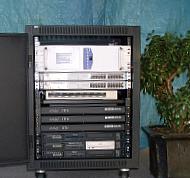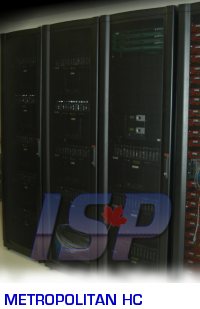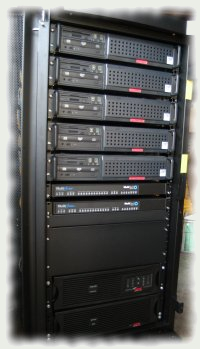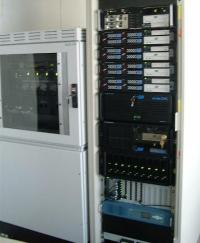
|
ISP Projects in Africa [Projects Portfolio] |
During the years in which ISP Ltd. was doing small-scale manufacturing of turnkey ISP networks we built and shipped packages to Angola, Nigeria, and Algeria, Africa. The first was a mid-range network to Luanda, Angola in 2002; the second an entry-level network to Port Harcourt, Nigeria in 2004; the third being a high-end network to Lagos, Nigeria; and the fourth an mid-range network to Oran, Algeria. The teams ranged from two to twenty people, which was quite efficient in size considering the difficulty in building, programming, documenting, exporting, and then training the customers. M&V Commsat, Luanda, Angola
In December 2001 M&V Commsat commissioned ISP Ltd. to build a Community HC network. The network was exported to Luanda, Angola in March 2002, followed by a team of three who guided the installation. The MV Commsat system featured:
The system provided premium Internet service to Luanda at speeds much in demand but until then unavailable in Angola. With their ISP system MV Commsat was able to offer 56k dial-up, ISDN dial-up, and wireless Internet access to thousands of Luanda businesses and residences. The wireless infrastructure, provided by an Australian company, allowed them to offer wireless connectivity that brought Internet to some businesses that had no high-speed wire options. We modified our standard Community HC design for MV Commsat since backbone bandwidth is extremely limited and expensive in Angola. The backbone limitation was the greatest challenge in this system design. To give them a strong competitive edge, we used our largest 8U proxy server design, housing ten Ultra-160 hard disk drives. The proxy server settings were fine-tuned to accommodate this configuration, and tested in our Colorado facility before shipment. To simulate the limited bandwidth we would encounter in Angola, we connected the server network to a low-speed wireless connection as the main backhaul. During the ten-day test run, we got the network operating at peak performance, tested components and procedures, and had the majority of programming done for their ISP. Once the testing phase was complete, we did the final programming for the IP blocks we would be using in Angola. A team of three went to Angola - a network engineer, an electrician / power technician, and a project coordinator. The installation went smoothly, especially so considering the obstacles we faced. The local telecom authority had not anticipated the size of network being installed and had to make some changes to their network to accommodate us. Much to their credit, Angola Telecom was quick to respond to our requests and worked diligently with us in solving the problems we encountered. In three years MV Commsat grew to cover all of Luanda, Angola with wireless Internet access, expanding from a single tower to ten, growing from a start-up to one of Angola's largest ISPs offering reliable service, server co-location, VoIP, SMS, and other communications services. In 2006 one of the directors told us that the reliability of the Linux servers provided by ISP Ltd. are what differentiated them from the competition, who were frequently experiencing down-time while M&V provided steady Internet service. A letter of recommendation from M&V Commsat may be viewed here. Access Point Ltd, Port Harcourt, Nigeria
In 2002/2003 we built an entry-level Neighbourhood ISP network for Access Point Communications Ltd in Port Harcourt, Nigeria. The owner was an entrepreneur who had started an Internet cafe in the city. The affordable Neighbourhood network allowed him to offer dial-up Internet to residents and enhanced Internet service to the patrons of his cafe. Monarch Communications (MonaCom), Lagos, Nigeria
In 2002 the team at Monarch Communications contacted us for help in designing a large metropolitan network that could provide Internet services for up to 100,000 subscribers. About two years were spent in the planning. ISP Ltd. was the designer of the network, but the production of such a large network was beyond our capability, so we partnered with the company who provided the dial-up terminal servers and built the network at their facility near Washington, DC. Production began in the Autumn of 2004 and the system was completed and shipped by the year's end. The completed network consisted of three 72U server racks, one communication rack, and two UPS racks. All of the servers were built using SuSE Enterprise Linux as a foundation and then many of the key server packages were built from source code to provide the latest versions. One of the unique characteristics of the network was that it featured a pure Linux router and firewall with 24 gigabit ports and a custom firewall designed for the client rather than the more common prebuilt router/firewall appliance. The back-haul to the Internet had to be via satellite since there was no availability of fibre-optic backbone connections to Africa in 2004, so the network included a powerful caching proxy server to store as much static data locally as possible and three DNS servers with the greatest amount of RAM that was possible to put in a server at that time. SAWTNET, Oran, Algeria
Following on the heals of Monarch was our next African system, a top-end entry-level Neighbourhood network with six 2U servers and two dial-up servers, plus UPS, contained in compact 42U rack for a French telecom that was testing feasibility of an Internet service in Algeria. The system went through six months of planning, followed by production in the summer of 2005. By the end of the summer the network was exported to Algeria from Victoria, BC. |

|